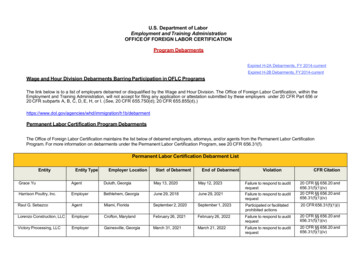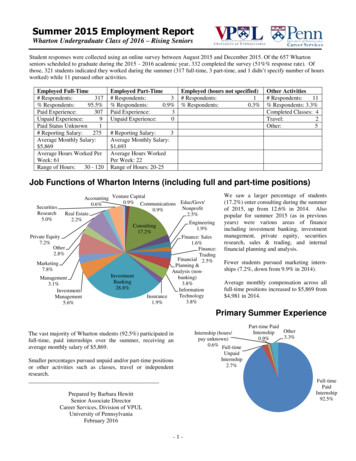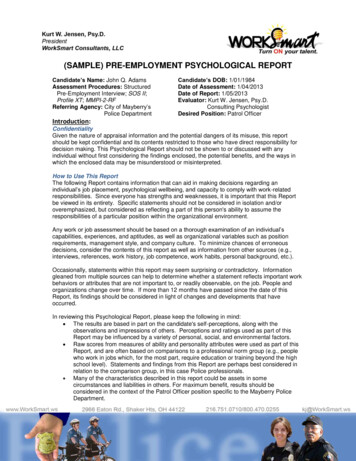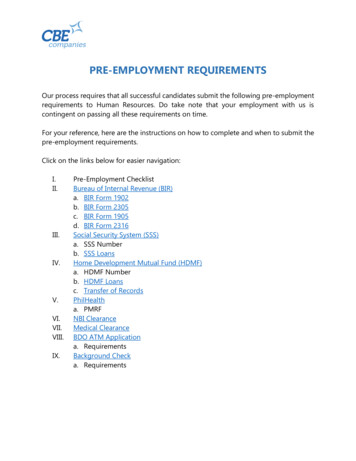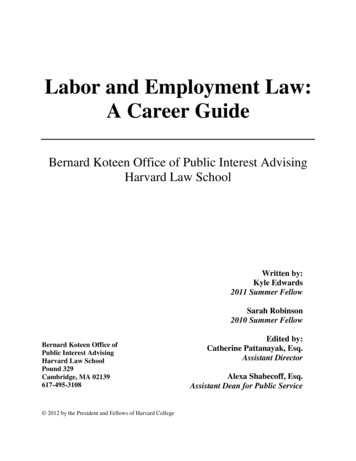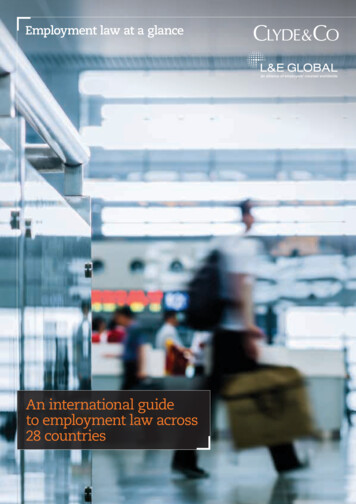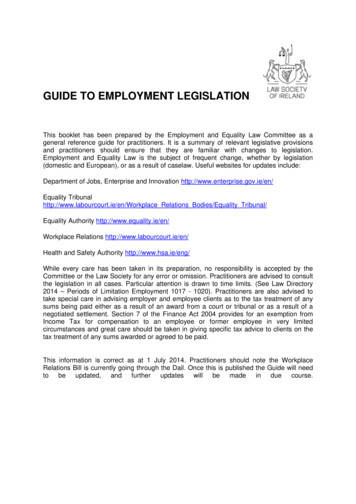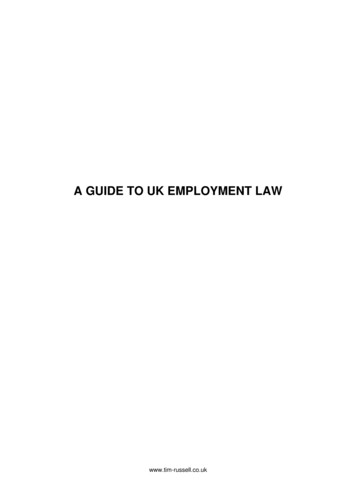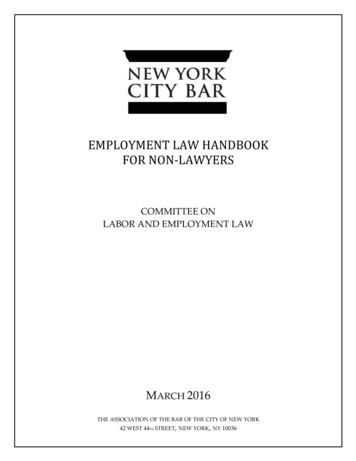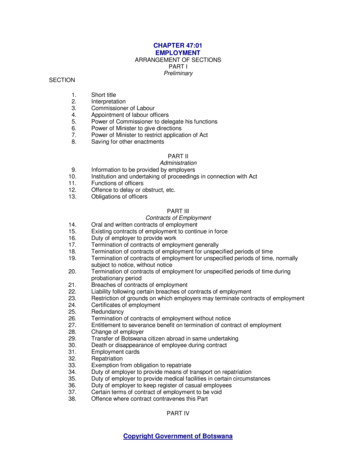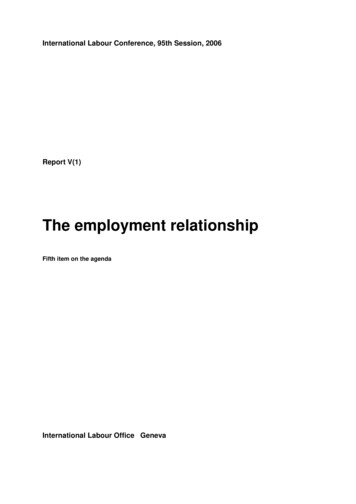
Transcription
International Labour Conference, 95th Session, 2006Report V(1)The employment relationshipFifth item on the agendaInternational Labour Office Geneva
ISBN 92-2-116611-2ISSN 0074-6681First published 2005The designations employed in ILO publications, which are in conformity with United Nations practice, and thepresentation of material therein do not imply the expression of any opinion whatsoever on the part of theInternational Labour Office concerning the legal status of any country, area or territory or of its authorities, orconcerning the delimitation of its frontiers.Reference to names of firms and commercial products and processes does not imply their endorsement by theInternational Labour Office, and any failure to mention a particular firm, commercial product or process is not asign of disapproval.ILO publications can be obtained through major booksellers or ILO local offices in many countries, or directfrom ILO Publications, International Labour Office, CH-1211 Geneva 22, Switzerland. Catalogues or lists ofnew publications are available free of charge from the above address, or by email: pubvente@ilo.org .Visit our web site: www.ilo.org/publns .Formatted by TTE: reference Confrep\ILC95(2006)\Report V(1)-2004-09-0068-1Printed in SwitzerlandATA
ContentsPageIntroduction .1Chapter I. The employment relationship: Overview of challenges and opportunities.3Evolution of the discussion at the ILO on the employment relationship .The employment relationship and the law .The employment relationship and workers’ protection.Context of the lack of protection.Repercussions of the lack of protection.Uncertainty with regard to the law .Closing the gap .Clarifying the scope of the law .Adjusting the limits of the legislation .Balancing equity and adaptability.Ensuring compliance.46889111515151616Chapter II. Trends and problems in regulation: A comparative analysis.19The law and the employment relationship .Substantive definitions .Descriptive definitions .Parties to the employment relationship .Determining the existence of an employment relationship.The principle of the primacy of fact .Determination by law .Easing the burden of proof.Clarifying the scope of the employment relationship .Defining the scope of the employment relationship .Delineating the boundary between dependent and independent work.The combined approach .Categorizing certain types of work .Extending the scope of legislation to equivalent workers .Developments in case law .Regulation of “triangular” employment relationships.Who is the employer (the provider)? .What is the position of the user? .What are the worker’s rights? .Compliance and enforcement .1920212224242628303133353738384242454750iii
The employment relationshipPageChapter III. A new instrument: The basis and possible content of a Recommendation .53Structure of the questionnaire .Content of the questionnaire .Section I: Form of the international instrument .Section II: Preamble.Section III: Content of the instrument .Section IV: Other issues.545454545558Questionnaire.59Annex 1. Resolution concerning the possible adoption of international instrumentsfor the protection of workers in the situations identified by the Committeeon Contract Labour .71Annex 2. Resolution concerning the employment relationship .72Annex 3. Employment by status in employment and sex, latest year .78Annex 4. List of referenced legislation .85iv
Introduction1. The question of the employment relationship will be examined according to thesingle-discussion procedure established in article 38 of the Standing Orders of theConference. The Office has accordingly produced the present summary report on lawand practice, which covers a broad spectrum of existing law and practice in more than 60ILO member States across different regions and different legal systems and traditions.The report provides a comparative analysis of the main developments and emergingtrends based on a review of the legal texts, case law and other forms of regulation. It isaccompanied by a questionnaire drawn up with a view to the preparation of aRecommendation. Governments are invited to give detailed replies to the questionnaire,on the basis of which the Office will prepare a final report in accordance with article 38,paragraph 2, of the Standing Orders of the Conference. This final report will contain adraft Recommendation for consideration by the Conference.2. In accordance with the provisions of article 38, paragraph 1, of the Standing Orders,the present report must reach governments not less than 18 months before the opening ofthe 95th Session of the Conference in 2006. In accordance with paragraph 2 of the samearticle, the final report must be communicated to governments not less than four monthsbefore the opening of the 95th Session of the Conference. So that the Office has time toexamine the replies to the questionnaire and prepare the final report, governments arerequested to ensure that their replies to the questionnaire reach the International LabourOffice in Geneva by 1 July 2005, or by 1 August 2005 in the case of federal countriesand countries where it is necessary to translate the questionnaire into the nationallanguage.3. The Office wishes to draw the attention of governments to article 38, paragraph 1,of the Standing Orders, which calls on them to consult the most representativeorganizations of employers and workers before they finalize their replies. Thegovernments’ replies should reflect the results of these consultations and indicate theorganizations consulted.4. This report is divided into three chapters as follows. Chapter I traces the evolutionover the last decade of the discussions at the ILO on the employment relationship,including the discussions on “contract labour” in 1997 and 1998, the 2000 Meeting ofExperts on Workers in Situations Needing Protection and the 2003 general discussion. Italso summarizes the most pertinent issues identified by the 39 national studies conductedin 1999-2001. Chapter II provides an overview of trends and problems in regard to themanner in which the general aspects of the employment relationship are regulated indifferent countries. This is based on a comparative analysis of the relevant laws of more1
The employment relationshipthan 60 ILO member States; it elaborates on and supplements the information on law andpractice provided in the report submitted for general discussion to the 91st Session of theInternational Labour Conference in 2003. 1 Chapter III briefly introduces the rationalebehind the questionnaire and outlines its structure and content.1ILO: The scope of the employment relationship, Report V, International Labour Conference, 91st Session,Geneva, 2003.2
Chapter IThe employment relationship: Overviewof challenges and opportunities5. The employment relationship is a legal notion widely used in countries around theworld to refer to the relationship between a person called an “employee” (frequentlyreferred to as “a worker”) and an “employer” for whom the “employee” performs workunder certain conditions in return for remuneration. It is through the employmentrelationship, however defined, that reciprocal rights and obligations are created betweenthe employee and the employer. The employment relationship has been, and continues tobe, the main vehicle through which workers gain access to the rights and benefitsassociated with employment in the areas of labour law and social security. It is the keypoint of reference for determining the nature and extent of employers’ rights andobligations towards their workers.6. The profound changes occurring in the world of work, and particularly in thelabour market, have given rise to new forms of relationship which do not always fitwithin the parameters of the employment relationship. While this has increasedflexibility in the labour market, it has also led to a growing number of workers whoseemployment status is unclear and who are consequently outside the scope of theprotection normally associated with an employment relationship. In 2004, the DirectorGeneral of the International Labour Office described the challenge as follows:The State has a key role to play in creating an enabling institutional framework to balancethe need for flexibility for enterprises and security for workers in meeting the changingdemands of a global economy . At the heart of national policies to meet the socialchallenges of globalization is a dynamic strategy for managing labour market change. 17. The legal framework governing the employment relationship is an importantcomponent of national policy for managing labour market change taking account of theneed for flexibility and security.8. The question of the employment relationship has, in one form or another, been onthe agenda of the International Labour Conference for over a decade. The following is anoverview of the evolution of these discussions culminating in the general discussion in2003. This chapter also summarizes the most pertinent issues raised in the nationalstudies conducted in 1999-2001, which formed the basis of the report prepared by theOffice for the 2003 general discussion and which are comprehensively analysed andreferenced in that report. 21ILO: A fair globalization: The role of the ILO, Report of the Director-General on the World Commission on theSocial Dimension of Globalization, International Labour Conference, 92nd Session, Geneva, 2004, p. 17.2ILO: The scope of the employment relationship, Report V, International Labour Conference, 91st Session,Geneva, 2003.3
The employment relationshipEvolution of the discussion at the ILOon the employment relationship9. The ILO has taken the employment relationship as the reference point forexamining various types of work relationships. In recent years, the Conference has helddiscussions on self-employed workers, migrant workers, homeworkers, privateemployment agency workers, child workers, workers in cooperatives, and workers in theinformal economy and in the fishing sector. It has also addressed work relationships inthe course of discussions on social security and maternity protection.10. In 1997 and 1998, the Conference examined an item on “contract labour”. 3 Theoriginal intention of the Conference discussion on “contract labour” was to protectcertain categories of unprotected workers through the adoption of a Convention and aRecommendation, but the proposal to adopt a Convention and Recommendation failed.However, at the end of the second discussion in 1998, the Conference adopted aresolution in which it invited the Governing Body of the ILO to place these issues on theagenda of a future session of the Conference with a view to the possible adoption of aConvention supplemented by a Recommendation if such adoption was, according to thenormal procedures, considered necessary by that Conference. The Governing Body wasalso invited to instruct the Director-General:(a)to hold meetings of experts to examine at least the following issues arising out ofthe delibe
associated with employment in the areas of labour law and social security. It is the key point of reference for determining the nature and extent of employers rights and obligations towards their workers. 6. The profound changes occurring in the world of work, and particularly in the labour market, have given rise to new forms of relationship which do not always fit within the parameters of .File Size: 495KBPage Count: 90

